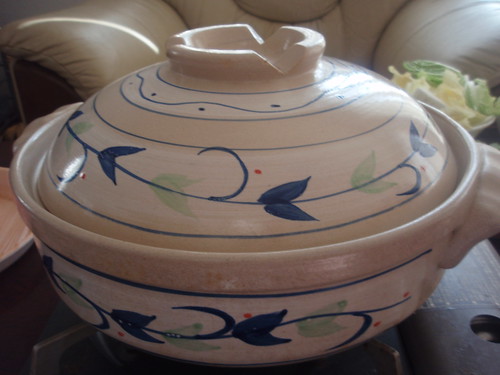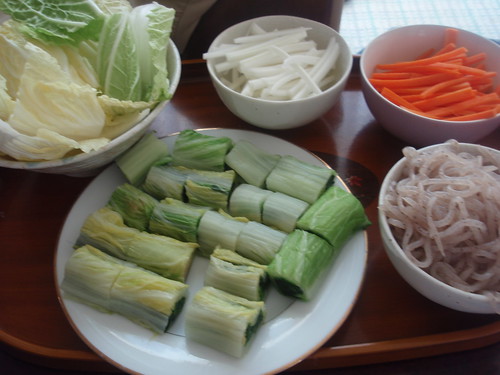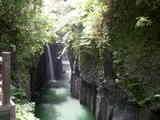
Ah, winter. What's better than soup? Not much, in my opinion. One pot cooking, that is good for me! Less dishes. Above is a picture of my 'do-nabe', or earthenware pot. It was a bargain, less than 500 yen! Unfortunately, it is not IH compatible, so I have to use my table-top burner for making nabe. My husband likes me to 'mostly cook' everything on the stove and then finish up on the dinner table. Those little cans of gas cost a lot! I guess I should be on the look-out for a new do-nabe. Anyway.
I have seen the word 'nabe' translated a few different ways, but I think of it as soup. The most common base is konbu, a type of dried seaweed. A four or five-inch piece of konbu should be wiped with a wet cloth and then soaked in water (in your pot) for a few hours. Heat up the water with the konbu inside, but remove it before the water starts to boil. I *think* it's edible, but I usually throw it away.
Common nabe ingredients are fish, thinly sliced beef or pork, tsukune (seasoned chicken meatballs) and assorted vegetables, carrots, daikon, hakusai (Chinese cabbage) and noodles (we usually use konnyaku noodles). But many shared dishes like this are good for cooking whatever you like. I rarely put fish in, because the broth takes on a decided fishy flavor. I have used globe fish on occasion, a nice light fish that doesn't 'fish up' the broth. I also like shrimp, but it's kind of a pain to shell them, so rarely add them.
I have learned to not add too much water at the beginning. If you do, you may be forced to throw away the broth when you finish, which is a shame because it can be so delicious. When ingredients are added, the water level rises, and if you don't have enough liquid for boiling the ingredients, you can always add more.
Cook meats and seafood first, because they need longer to cook and you really don't want to be eating half-cooked shrimp, do you? Skim off any scum because you want to keep your broth clear. Next, add the veggies that take longer to cook, such as carrots and daikon, and the white part of the Chinese cabbage. Konnyaku noodles taste better after being boiled for five or so minutes, so add those fairly early, too.
Nabe is a meal that's meant to be eaten at the table with family, cooking as you go. You can cook as much or as little as you like before sitting down to eat, it's up to you. Some people like to serve rice with nabe, while others will present it half-way through. One other method is to make rice porridge (next post) which takes advantage of all that left-over broth.
Sunday, February 17, 2008
nabe
Subscribe to:
Post Comments (Atom)

1 comments:
This is a pretty design on the earthenware pot for Nabe. I have not heard of it before. Nice idea to make soup, Japanese style. I have not seen on menu in American restaurants that are Japanese, but glad to come across your blog. Please continue more of your cooking photos. Grace In New Jersey, USA.
Post a Comment